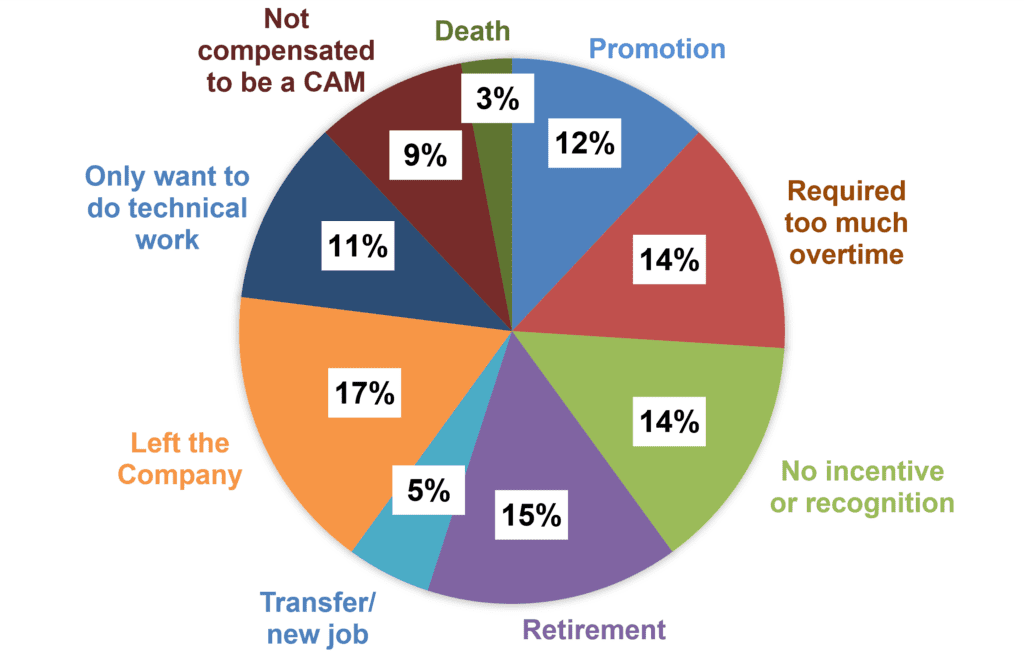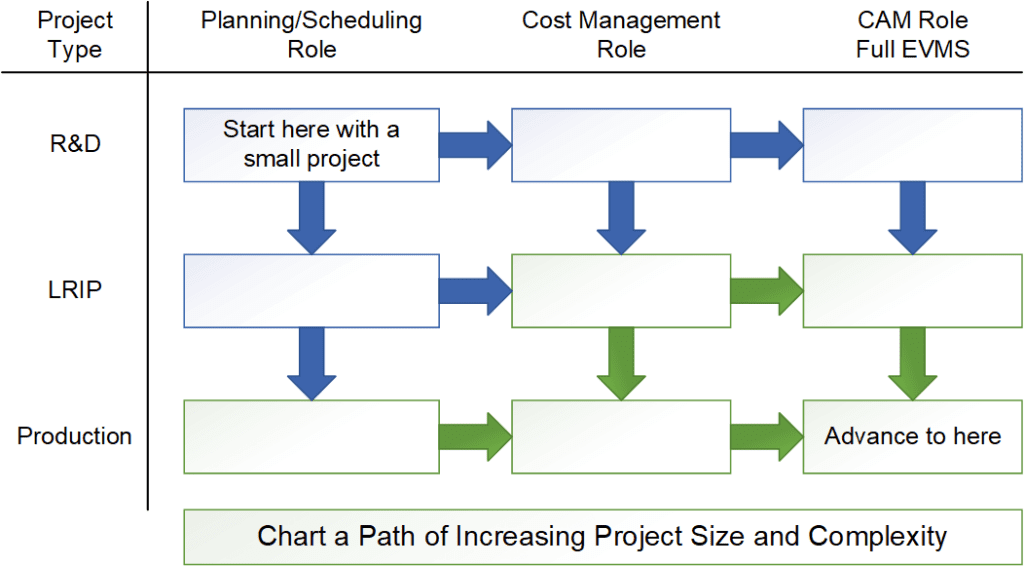
A long running challenge all companies face is attracting and retaining top project management talent in government contracting environments whether for the DoD, shipbuilding, NASA, DOE, or the intelligence community. Experienced program/project managers, control account managers (CAMs), schedulers, and project control analysts are always in short supply. It is expensive to continually hire and train new employees that elect to move on for a variety of reasons; successful strategies aimed at reducing turnover always help the financial bottom line.
An informal survey H&A earned value consultants recently conducted with corporate business managers and Earned Value Management System (EVMS) directors of A&D and DOE contractors highlighted this challenge of retaining top talent. One contractor surveyed had a 50% annual turnover rate in CAMs that was impacting their ability to sustain their EVMS best practices. The reasons the CAMs gave the business managers or EVMS directors for moving on are summarized in the following pie chart.

While some items are outside the control of a manager or director such as retirement and potentially leaving the company (which may have an underlying root cause related to other reasons cited), a good percentage could be addressed with a formal training and retention program. For example, adding up required too much overtime (14%), no incentive or recognition (14%), only want to do technical work (11%), and not compensated to be a CAM (9%) adds up to 48% of the reasons why they moved on.
Establishing a Training and Retention Program
A strategy some companies have implemented to address this retention challenge is to establish a career path for talented technical, estimating, scheduling, and cost management project personnel with a formal training and retention program that aligns with their professional objectives. A successful approach for retaining and promoting motivated project personnel H&A earned value consultants have seen implemented at some A&D contractors included the following tactics.
- Management established a formal training and promotion program for potential CAMs that new employees learn about as part of their on-boarding process. The program is meant to be an incentive for potential employees to come work for the company. These new employees are introduced to their options and the training/promotion process to help them chart their career goals and set expectations. The message to new employees is that the company is committed to helping them determine and achieve their professional goals.
- The companies hired a blend of technical engineering, cost estimating, scheduling, and cost management project personnel with the anticipation they would move up through the role of a CAM with expanding responsibilities and higher management levels. This was clearly communicated to the new employees as part of the process to chart their career goals within the company.
- They assigned a mentor to help guide them through the training and promotion program. This provided two benefits to the company: a) management was able to quickly identify talented and motivated employees and 2) employees had a direct connection to leadership that could help them align their talents with career paths within the company. It also helps the company to identify those employees that want to excel within their chosen discipline such as systems engineering or scheduling; not everyone will want to follow the path to become a CAM.
- They cross trained the personnel in the different disciplines required for a best in class EVMS to increase their skill levels and knowledge base required for an integrated system. This was required training for new employees. For example, the cost estimators or cost management personnel learned about scheduling techniques and the schedulers learned about cost management techniques. Technical personnel learned about schedule and cost techniques. EVM concepts and best practices as well as schedule and cost performance analysis were part of the standard curriculum for everyone.
- For those employees that wanted to continue moving up through the CAM role to higher management levels, advanced training was required. Training in other disciplines were woven in such as risk management, resource management, material management, subcontract management, financial analysis, and advanced project performance analysis to broaden their knowledge base. These employees were tested, certified, and earned a bonus upon gaining their certifications that ranged from $5K to $10K.
Typical certifications included the Project Management Institute (PMI) Project Management Professional (PMP) as a foundation. The Association for the Advancement of Cost Engineering (AACE) International offers targeted certifications such as their Certified Cost Professional (CCP), Certified Estimating Professional (CEP), and Earned Value Professional (EVP). More advanced course work often included the H&A Advanced Earned Value Management Techniques (AEVMT) workshop, CAM Certification workshop, or the Project Controls/Analyst (PC/A) Certification workshop. - The employee’s mentor helped them to chart a path starting with smaller projects in a planning and scheduling role and then advancing them through different project types and project control roles to larger more complex projects so they could gain hands-on experience in each environment. This approach helped them to broaden their knowledge base across disciplines, improve their skill sets, and learn how to successfully handle increasingly complex project control challenges as well as develop an internal professional network. There were various paths they could follow to progressively gain more experience. The end goal was to become a CAM on a large complex project in preparation for becoming a project manager. This is illustrated in the following image.

- Successful CAMs that completed this advancement plan were then moved up to higher management roles such as project managers, business managers, and corporate EVMS directors. For example, one company established a program like this and seven years later, the majority of project managers, business managers, and corporate directors came through this program. The company also offered bonuses for successfully achieving major project milestones or other events such as Integrated Baseline Reviews (IBRs) to keep them focused.
- Senior CAMs, project managers, business managers, and corporate directors were the instructors for internal project management and EVM training as well as mentors. This demonstrated to project personnel that excellence in integrated program management was a fundamental component of the company’s business culture.
Essential Components
Common attributes of successful training and retention programs included:
- Establishing a program with a defined training and career path to guide and mentor motivated employees whether beginning from a technical, schedule, or cost discipline up through the role of CAMs. The path to become a project manager or high level manager starts with the role of CAM.
- Project managers, executive managers and directors conduct the internal project management and EVM training. They are the mentors to junior personnel. They establish the corporate business culture that highlights excellence in project management is a priority. Exceptional project execution results in better financial performance. A commitment to excellence creates a better working environment that reduces the stress level for CAMs and project managers because there is a proven process in place to help ensure achievable project goals have been established.
- Motivated employees are rewarded for improving and broadening their skill sets, experience, and knowledge base. They are recognized for their high level of proficiency as well as their role in establishing and maintaining a best in class EVMS regardless of the project they are supporting. Recognition can take many forms that can be tailored to what is important to an employee, whether as bonuses, awards, additional training, or promotions.
Retaining top project management talent requires a plan and strategy corporate management is invested in and actively maintains. It is an inherent component of the corporate culture that demonstrates a commitment to excellence in project management and sustaining a best in class EVMS.
H&A earned value consultants often help corporate business managers and EVM directors chart out training plans for cross-training project personnel and helping them establish internal CAM or project controls certification programs. Licensing H&A training materials or Virtual Learning Lab (VLL) scheduling and EVM online training reduces the time required to develop and maintain training materials. We can do the same for you. Give us a call today at (714) 685-1730.
